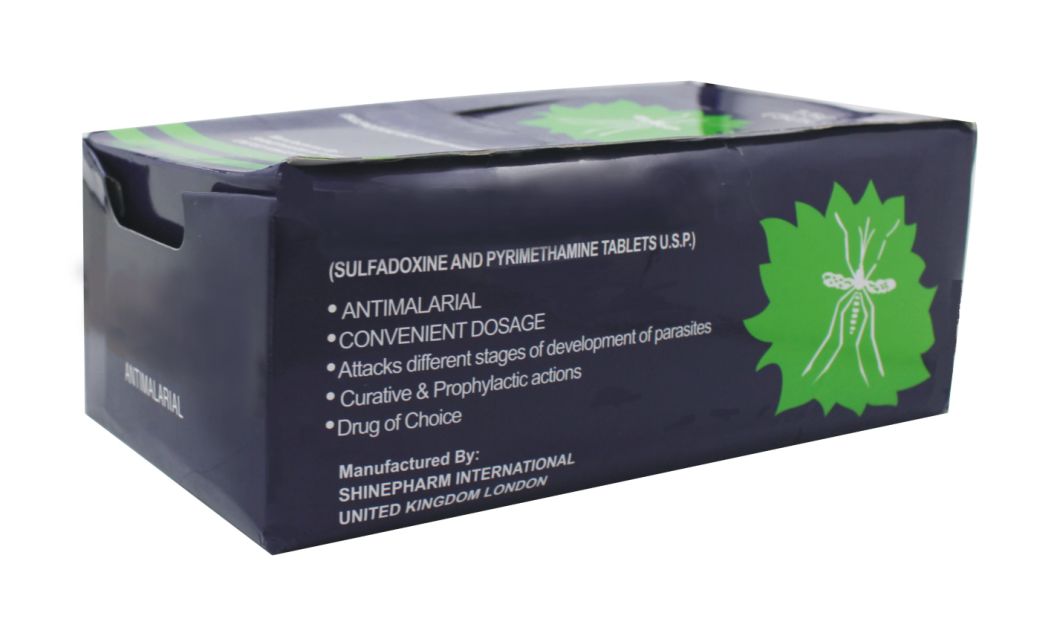Sulfadoxine Pyrimethamine Tablets 500+25mg, 50X3 OEM
2018-10-26 09:01:49
Model NO.: AMC12031-02
Pharmaceutical Technology: Chemical Synthesis
Trademark: MEDIPHARM/OEM
Transport Package: 50X3
Specification: 500+25mg
Origin: China
HS Code: 3004901000
Model NO.: AMC12031-02
Pharmaceutical Technology: Chemical Synthesis
Trademark: MEDIPHARM/OEM
Transport Package: 50X3
Specification: 500+25mg
Origin: China
HS Code: 3004901000
Indications:Treatment of acute uncomplicated Plasmodium falciparum malaria for patients in whom chloroquine resistance is suspected; malaria prophylaxis for travelers to areas where chloroquine-resistant P. falciparum malaria is endemic and sensitive to sulfadoxine/pyrimethamine and when alternative therapy is not available or contraindicated. Malaria prophylaxis with sulfadoxine/pyrimethamine is not routinely recommended.Adverse Effects:
Agranulocytosis, aplastic anemia, megaloblastic anemia, thrombocytopenia, leukopenia, hemolytic anemia, purpura, hypoprothrombinemia, methemoglobinemia, and eosinophilia.
Erythema multiforme, Stevens-Johnson syndrome, generalized skin eruptions, toxic epidermal necrolysis, urticaria, serum sickness, pruritus, exfoliative dermatitis, anaphylactoid reactions, periorbital edema, conjunctival and scleral injection, photosensitization, arthralgia, allergic myocarditis, slight hair loss, Lyell's syndrome,
Glossitis, stomatitis, nausea, emesis, abdominal pains, hepatitis, hepatocellular necrosis, diarrhea, pancreatitis, feeling of fullness, and transient rise of liver enzymes.
Headache, peripheral neuritis, mental depression, convulsions, ataxia, hallucinations, tinnitus, vertigo, insomnia, apathy, fatigue, muscle weakness, nervousness, and polyneuritis.
Pulmonary infiltrates resembling eosinophilic or allergic alveolitis.
Renal failure, interstitial nephritis, BUN and serum creatinine elevation, toxic nephrosis with oliguria and anuria, and crystalluria.
Drug fever, chills, periarteritis nodosa and LE phenomenon have occurred.
Contra-indications:
Repeated prophylactic (prolonged) use in patients with severe renal or hepatic failure, or blood dyscrasias; documented megaloblastic anemia caused by folate deficiency; use in infants younger than 2 mo of age; prophylactic use in pregnancy at term and during lactation; hypersensitivity to pyrimethamine, sulfonamides, or any other ingredient of sulfadoxine/pyrimethamine.
Warning:
Fatalities associated with the administration of sulfonamides, although rare, have occurred due to severe reactions, including fulminant hepatic necrosis, agranulocytosis, aplastic anemia and other blood dyscrasias. Fansidar (sulfadoxine and pyrimethamine) prophylactic regimen has been reported to cause leukopenia during a treatment of 2 months or longer. This leukopenia is generally mild and reversible.
Precautions:
Oral Sulfadoxine and Pyrimethamine has not been evaluated for the treatment of cerebral malaria or other severe manifestations of complicated malaria, including hyperparasitemia, pulmonary edema or renal failure. Patients with severe malaria are not candidates for oral therapy. In the event of recrudescent P. falciparum infections after treatment with Fansidar (sulfadoxine and pyrimethamine) or failure of chemoprophylaxis with Fansidar (sulfadoxine and pyrimethamine) , patients should be treated with a different blood schizonticide.
Sulfadoxine and Pyrimethamine should be given with caution to patients with impaired renal or hepatic function, to those with possible folate deficiency and to those with severe allergy or bronchial asthma. As with some sulfonamide drugs, in glucose-6-phosphate dehydrogenase-deficient individuals, hemolysis may occur. Urinalysis with microscopic examination and renal function tests should be performed during therapy of those patients who have impaired renal function. Excessive sun exposure should be avoided.
Storage instructions:
Store below 25ºC. Protect from moisture and light. Keep out of reach of children.

 Indications:Treatment of acute uncomplicated Plasmodium falciparum malaria for patients in whom chloroquine resistance is suspected; malaria prophylaxis for travelers to areas where chloroquine-resistant P. falciparum malaria is endemic and sensitive to sulfadoxine/pyrimethamine and when alternative therapy is not available or contraindicated. Malaria prophylaxis with sulfadoxine/pyrimethamine is not routinely recommended.
Adverse Effects:
Agranulocytosis, aplastic anemia, megaloblastic anemia, thrombocytopenia, leukopenia, hemolytic anemia, purpura, hypoprothrombinemia, methemoglobinemia, and eosinophilia.
Erythema multiforme, Stevens-Johnson syndrome, generalized skin eruptions, toxic epidermal necrolysis, urticaria, serum sickness, pruritus, exfoliative dermatitis, anaphylactoid reactions, periorbital edema, conjunctival and scleral injection, photosensitization, arthralgia, allergic myocarditis, slight hair loss, Lyell's syndrome,
Glossitis, stomatitis, nausea, emesis, abdominal pains, hepatitis, hepatocellular necrosis, diarrhea, pancreatitis, feeling of fullness, and transient rise of liver enzymes.
Headache, peripheral neuritis, mental depression, convulsions, ataxia, hallucinations, tinnitus, vertigo, insomnia, apathy, fatigue, muscle weakness, nervousness, and polyneuritis.
Pulmonary infiltrates resembling eosinophilic or allergic alveolitis.
Renal failure, interstitial nephritis, BUN and serum creatinine elevation, toxic nephrosis with oliguria and anuria, and crystalluria.
Drug fever, chills, periarteritis nodosa and LE phenomenon have occurred.
Contra-indications:
Repeated prophylactic (prolonged) use in patients with severe renal or hepatic failure, or blood dyscrasias; documented megaloblastic anemia caused by folate deficiency; use in infants younger than 2 mo of age; prophylactic use in pregnancy at term and during lactation; hypersensitivity to pyrimethamine, sulfonamides, or any other ingredient of sulfadoxine/pyrimethamine.
Warning:
Fatalities associated with the administration of sulfonamides, although rare, have occurred due to severe reactions, including fulminant hepatic necrosis, agranulocytosis, aplastic anemia and other blood dyscrasias. Fansidar (sulfadoxine and pyrimethamine) prophylactic regimen has been reported to cause leukopenia during a treatment of 2 months or longer. This leukopenia is generally mild and reversible.
Precautions:
Oral Sulfadoxine and Pyrimethamine has not been evaluated for the treatment of cerebral malaria or other severe manifestations of complicated malaria, including hyperparasitemia, pulmonary edema or renal failure. Patients with severe malaria are not candidates for oral therapy. In the event of recrudescent P. falciparum infections after treatment with Fansidar (sulfadoxine and pyrimethamine) or failure of chemoprophylaxis with Fansidar (sulfadoxine and pyrimethamine) , patients should be treated with a different blood schizonticide.
Sulfadoxine and Pyrimethamine should be given with caution to patients with impaired renal or hepatic function, to those with possible folate deficiency and to those with severe allergy or bronchial asthma. As with some sulfonamide drugs, in glucose-6-phosphate dehydrogenase-deficient individuals, hemolysis may occur. Urinalysis with microscopic examination and renal function tests should be performed during therapy of those patients who have impaired renal function. Excessive sun exposure should be avoided.
Storage instructions:
Store below 25ºC. Protect from moisture and light. Keep out of reach of children.

Â
our pig ear tags are a high-quality female ear tag part for cattle.
MS Tag Jumbo ear tags are available in various colours.
High flexibility
UV resistant
Wear resistant
Perforation: closed
Unprinted
Packaging: resealable plastic bag
more colors to choose
Pig Ear Tag are special for tagging on both of the ears of a pig to idendficate .
Pig Ear Tag
Pig Ear Tag,Ear Tag For Pig,Animal Ear Tag For Pig,Laser Printing Ear Tag
BAOYING CHENGDONG SOCIETY WELFARE FACTORY , http://www.icareartag.com